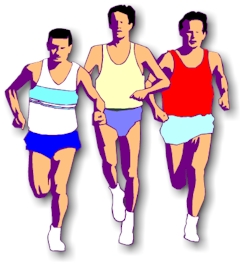

Cognitive Strategies for Competition


Cognitive Strategies for Competition
![]()
 Morgan(1978)發現大部分參與耐力性項目的運動員,都會把注意力抽離(dissociate)於該運動項目和自身的感覺[1],以消除這類耐力性項目所帶來的沉悶和痛楚。例如,一些耐力性項目的運動員,在從事運動的同時,就會一邊想像其他的事情,或作一些複雜的數學運算,又或者在心中歌唱等。雖然他們的注意力是內在的(因為都放到思想上面),但卻是刻意把思想抽離所從事的活動和自身感覺。Pennebaker
與 Lightner(1980)也發現,分散注意力(dissociate)能降低進行跑步機練習時的疲勞程度;此外,進行野外跑時(較容易分散精神)的成績要比在田徑場上連續跑圈好。
Morgan(1978)發現大部分參與耐力性項目的運動員,都會把注意力抽離(dissociate)於該運動項目和自身的感覺[1],以消除這類耐力性項目所帶來的沉悶和痛楚。例如,一些耐力性項目的運動員,在從事運動的同時,就會一邊想像其他的事情,或作一些複雜的數學運算,又或者在心中歌唱等。雖然他們的注意力是內在的(因為都放到思想上面),但卻是刻意把思想抽離所從事的活動和自身感覺。Pennebaker
與 Lightner(1980)也發現,分散注意力(dissociate)能降低進行跑步機練習時的疲勞程度;此外,進行野外跑時(較容易分散精神)的成績要比在田徑場上連續跑圈好。
不過,Morgan (1978)亦發現成績優異的運動員,不但不會把注意力抽離於正在從事的活動和自身的感覺,反而會把注意力集中於這兩方面(associate)。除了這些內在的感覺外,他們還會留意到對手和外在環境的變化,並且不時會把注意力轉移於外在環境和內在感覺之間,以調整步速和技術,從而提高運動表現。例如,Morgan 等(1988)以精英跑步運動員為對像的一項研究就發現,72% 的精英跑步運動員在比賽時會把注意力集中在該項目和自身的感覺(associate),而其餘的 28% 會用上兩種注意力的集中形式(即 associate 及 dissociate)。但是,在訓練的時候,21% 會把注意力集中在自身感覺(associate),43% 會把注意力抽離其中(dissociate),而其餘的 36% 會用上兩種方法。Masters 與 Ogles(1998)回顧了 35 份相關的研究(主要都和跑步有關)後發現, 一般來說,集中於自身感覺的方法(association)與跑步成績有正相關,也就更加肯定了 Morgan(1978)的發現。
|
中長跑的戰術運用 合理地分配體力是中長跑取得理想成績的主要策略,一般來說:
|
![]()
1 這等感覺提供了肌肉中的力量和方向感等信息,也經常被稱為運動感覺(kinesthesis)。運動感覺的信息主要來自內耳的前庭器官、關節囊內的感受器、肌肉內的肌紡錘(muscle spindles)、肌鍵內的高爾基感受器(Gogi tendon organs)和皮膚的感受器等;這種種的信息再由中樞神經系統總其成為運動感覺。

注意力的重要 |
|
注意力的度向 |
![]()
![]()
References
![]()
Gadsdon, S. (2001). Psychology and Sport. Oxford: Heinemann.
Masters, K. S. & Ogles, B. M. (1998). Associative and dissociative cognitive strategies in exercise and and running: 20 years later, what do we know? The Sport Psychologists, 12, 253-270.
Morgan, P. (1978, April). The mind of the marathoner. Psychology Today, pp. 38-49.
Morgan, W. P., O'Connor, P. J., Ellickson, K. A., & Bradley, P. W. (1988). Personality structure, mood states, and performance in elite male distance runners. International Journal of Sport Psychology, 19, 247-263.
Pennebaker, J. W. & Lightner, J. M. (1980). Competition of internal and external information in an exercise setting. Journal of Personality and Social Psychology, 39, 165-174.
![]()

Back to Psychological Aspects of
Running
最近更新日期(Last Updated):2007-06-25